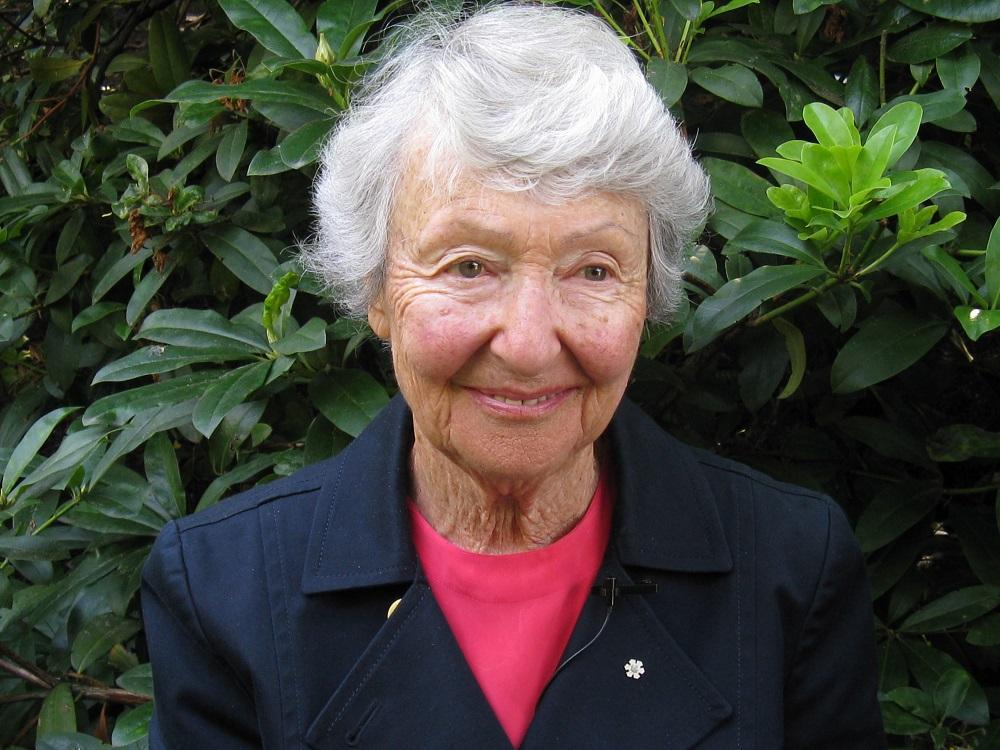Cornelia Hahn Oberlander, born in 1921 in Germany, moved to the United States in 1939, and studied at Smith College in Massachusetts. In 1944, she began her studies at Harvard University Graduate School of Design under Walter Gropius, designing her first projects in New York City and at the Citizen’s Council on City Planning in Philadelphia, where she worked as a Community Planner. Early public housing projects included Schuylkill Falls, working with landscape architect Dan Kiley, and Mill Creek Housing, working with Kiley and architect Louis Kahn. In 1953, Oberlander moved to Vancouver, BC with her husband, undertaking a number of municipal projects, including the landscape for Skeena Terrace low rent housing.
1967 saw the launch of her acclaimed Children’s Creative Centre Playground at the International Exposition of 1967 (Expo ’67) in Montreal, a design based on children’s spontaneity and exploration and serving over 300,000 over the duration of the exposition. Over time, Oberlander would design a total of seventy playgrounds in Canada as well as contribute towards establishing a national Task Force on Play. In 1975, her collaboration with Arthur Erickson on Robson Square in Vancouver resulted in an early roof garden, three blocks long, for the Provincial Government Complex. She continues to create designs for universities, governments, schools and private residences, most recently completing her vision for the roof of the Vancouver Public Library, which opened to the public in 2018.
Oberlander is the recipient of numerous awards, including the Governor General’s Medal in Landscape Architecture (2016); named a Companion of the Order of Canada (2017); and recognized as a Fellow of both the Canadian and the American Societies of Landscape Architects. As a testament to Oberlander’s legacy, the Cultural Landscape Foundation recently announced the Cornelia Hahn Oberlander International Landscape Architecture Prize. The Oberlander Prize is the first and only international landscape architecture prize to include a US $100,000 monetary award. The Oberlander Prize will be conferred biennially, beginning in 2021.
Cornelia Oberlander passed away on May 22, 2021. Her passing has been noted in The New York Times and The Globe and Mail.
Cornelia Hahn Oberlander est née en Allemagne en 1921, a déménagé aux États-Unis en 1939, et a étudié au Smith College, dans le Massachusetts. En 1944, elle a entamé ses études à la Graduate School of Design de l’Université Harvard, sous l’enseignement de Walter Gropius, et a conçu ses premiers projets à New York et en tant que planificatrice communautaire au Citizens’ Council on City Planning, à Philadelphie. Ses premiers projets de logements sociaux incluent Schuylkill Falls, où elle a travaillé avec l’architecte paysagiste Dan Kiley, et Mill Creek Housing, avec Kiley et l’architecte Louis Kahn. En 1953, Oberlander a déménagé avec son mari à Vancouver, en Colombie-Britannique, et a entrepris de nombreux projets municipaux, dont les logements à coût modique Skeena Terrace.
Elle a révélé son projet acclamé, le Centre d’activités créatrices pour enfants, à l’Exposition universelle de 1967 (Expo 67), à Montréal. Avec son design inspiré de la spontanéité et de l’exploration des enfants, le projet a desservi plus de 300 000 personnes durant l’exposition. Oberlander a réalisé plus de 70 terrains de jeux au Canada, en plus d’avoir contribué à la mise en place d’un groupe de travail national sur les jeux pour enfants. En 1975, sa collaboration avec Arthur Erickson sur le Robson Square, à Vancouver, a donné lieu à l’un des tous premiers toits végétalisés, d’une longueur de trois pâtés de maison, pour le complexe du gouvernement provincial. Elle continue de créer des designs pour des universités, des gouvernements, des écoles et des résidences privées, la plus récente étant sa vision pour le toit de la bibliothèque municipale de Vancouver, qui a ouvert ses portes au public en 2018.
Oberlander est récipiendaire de nombreux prix, dont la Médaille du Gouverneur général en architecture paysagère (2016); elle a été nommée Compagnon de l’Ordre du Canada (2017); et elle est membre de l’Association des architectes paysagistes du Canada et de la Société américaine des architectes paysagistes. Afin de faire honneur à l’héritage légué par Oberlander, la Cultural Landscape Foundation a récemment annoncé le lancement du Cornelia Hahn Oberlander International Landscape Architecture Prize. Il s’agit du premier et seul prix international en architecture paysagère à offrir une récompense monétaire de 100 000 $ US. Le Oberlander Prize sera accordé sur une base biennale à compter de 2021.




